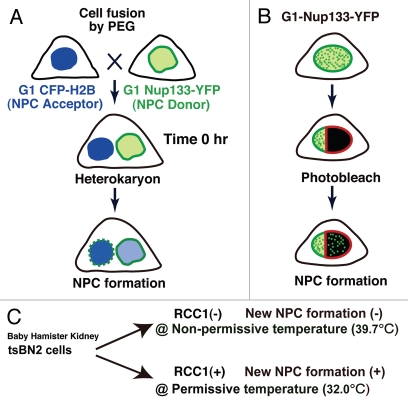Figure 2.
(A) Schematic representation of the heterokaryon procedure. HeLa cells expressing Nup133-YFP or YFP-Nup107 are used as NPC donor cells and HeLa cells expressing CFP-histone 2B (H2B) were used as NPC acceptor cells (top). G1-synchronized donor and acceptor cells were treated with 50% (w/v) polyethylene glycol (PEG) to make heterokaryons (middle). Many bright fluorescent dots appear on the NPC acceptor nuclear surface, which has the brighter CFP-H2B signal, in the heterokaryon cells. The bright foci represent newly formed NPCs (bottom). (B) The photobleaching method. Nuclear surface regions in G1-phase cells expressing Nup133-YFP or YFP-Nup107 were photobleached by a 488 nm laser (middle). At 16 h after bleaching, many bright YFP dots appear in the bleached areas, representing newly synthesized NPCs (bottom). (C) In the tsBN2 cell, which is a temperature-sensitive mutant of RCC1 that is a guanine nucleotide exchange factor for Ran, a loss of RCC1 inhibits NPC formation during interphase. This allows the inhibition or initiation of NPC formation by changes in temperature. In this system, interphase NPC formation actively occurs at permissive temperature (32°C), but not at non-permissive temperature (39.7°C).

